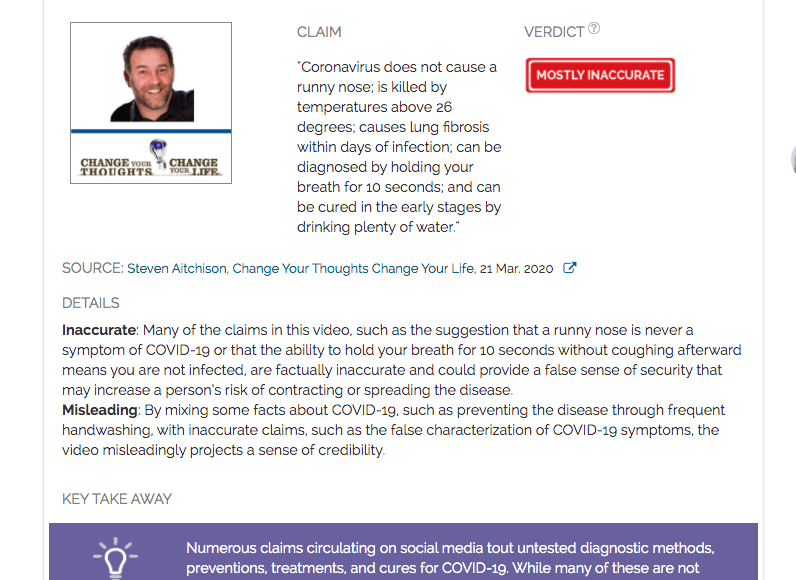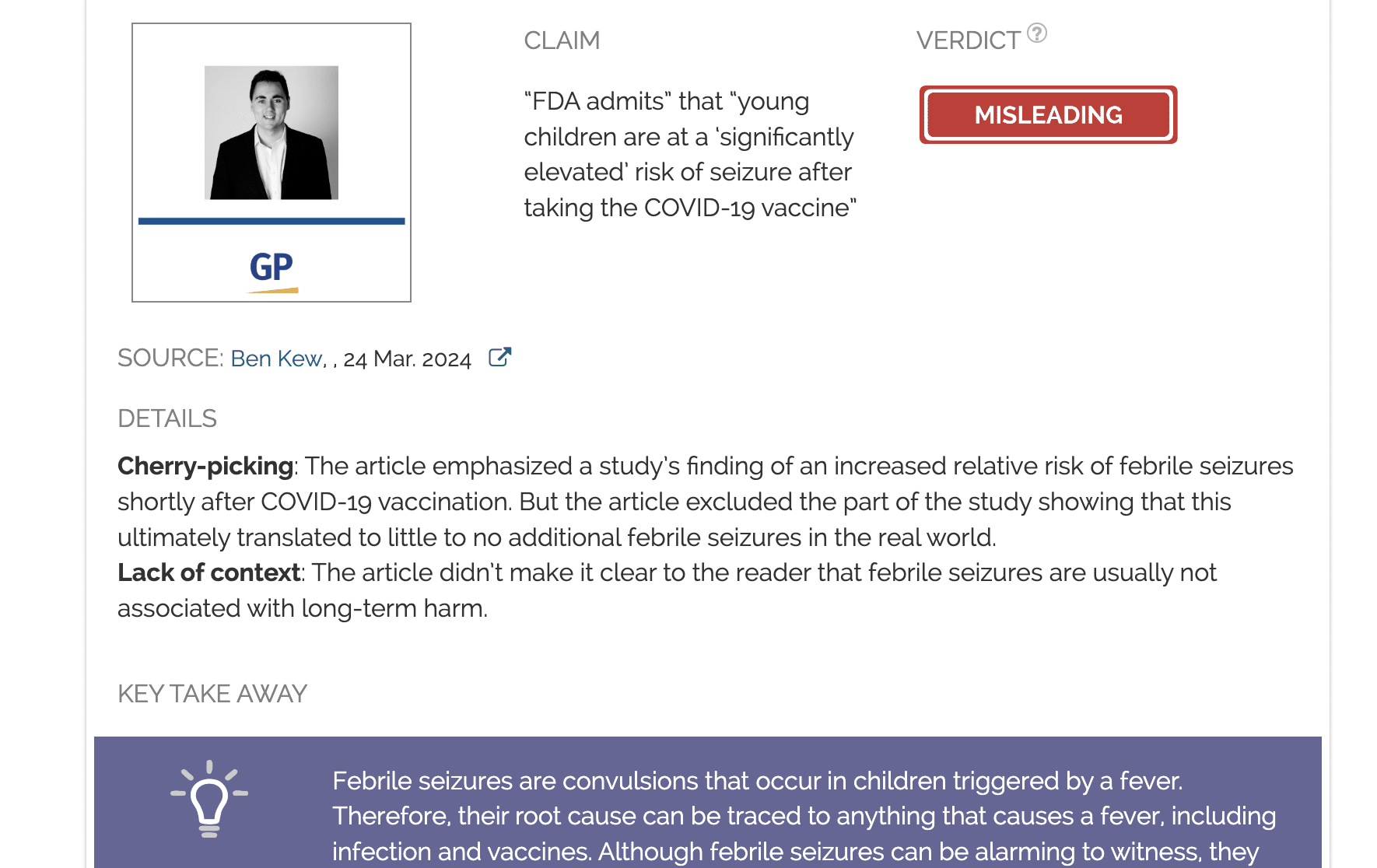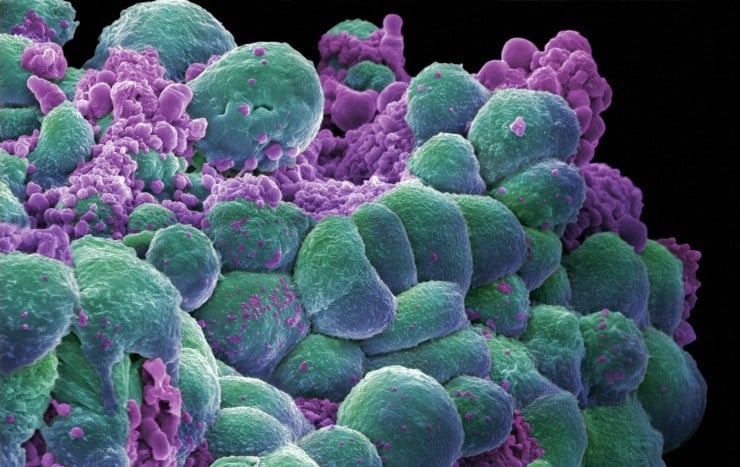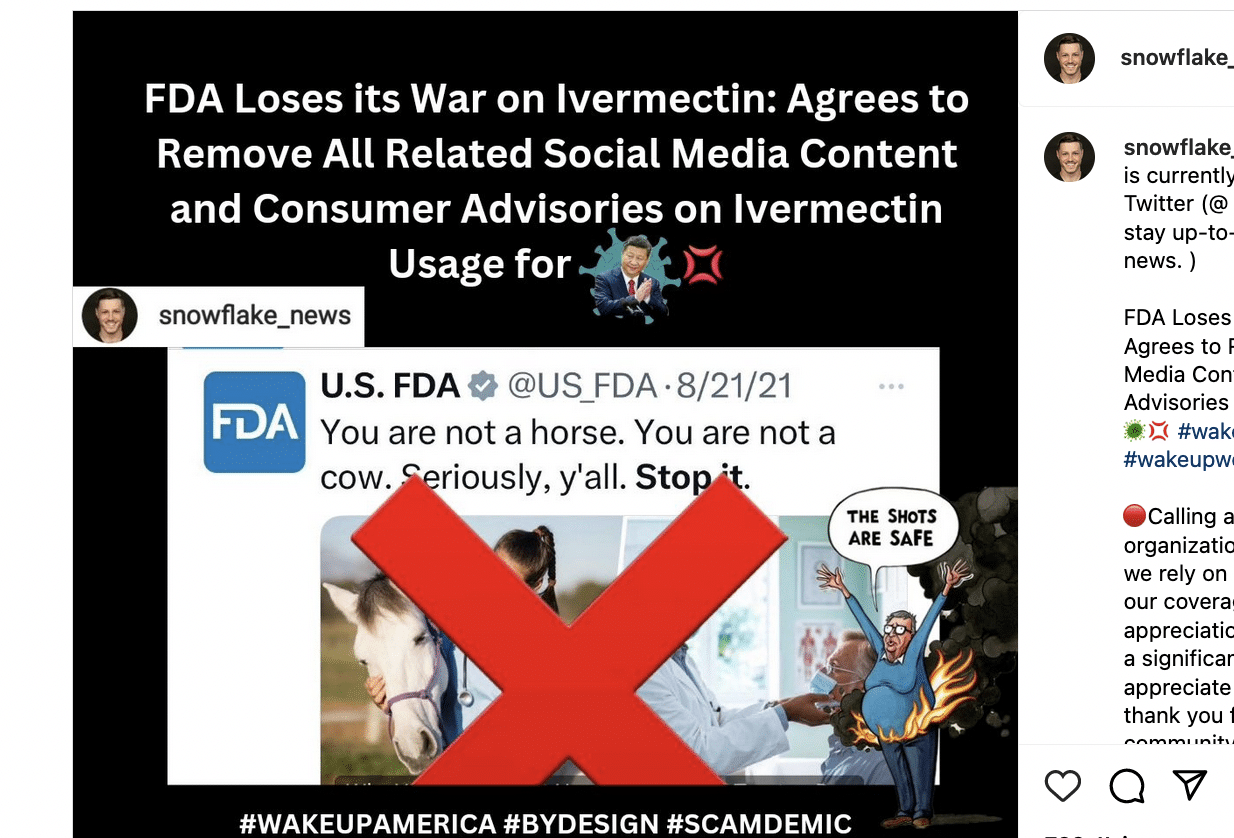- Health
Viral video mixes truth about COVID-19 with a long list of ineffective treatments and preventions
Key takeaway
Numerous claims circulating on social media tout untested diagnostic methods, preventions, treatments, and cures for COVID-19. While many of these are not harmful by themselves, they could potentially induce a false sense of security that causes individuals to ignore basic, tested precautionary measures such as frequent handwashing, disinfecting surfaces, avoiding touching the face, social distancing, and self-isolation when sick, which have all proven effective in slowing the spread of the pandemic.
Reviewed content

Verdict:
Claim:
Coronavirus does not cause a runny nose; is killed by temperatures above 26 degrees; causes lung fibrosis within days of infection; can be diagnosed by holding your breath for 10 seconds; and can be cured in the early stages by drinking plenty of water.
Verdict detail
Inaccurate: Many of the claims in this video, such as the suggestion that a runny nose is never a symptom of COVID-19 or that the ability to hold your breath for 10 seconds without coughing afterward means you are not infected, are factually inaccurate and could provide a false sense of security that may increase a person’s risk of contracting or spreading the disease.
Misleading: By mixing some facts about COVID-19, such as preventing the disease through frequent handwashing, with inaccurate claims, such as the false characterization of COVID-19 symptoms, the video misleadingly projects a sense of credibility.
Full Claim
Coronavirus does not cause a runny nose; is killed by temperatures above 26 degrees; requires social distancing of 10 feet; can live for 12 hours on metal surfaces; can live up to 12 hours on fabric but is killed by normal laundry detergent; is killed by drinking warm water or gargling salt water; can live on the skin up to 10 minutes; starts with infection in the throat and then moves to the lungs where it causes pneumonia; may not show symptoms for days after infection; causes lung fibrosis within days of infection; can be diagnosed by holding your breath for 10 seconds; and can be cured in the early stages by drinking plenty of water.
Summary
A viral video has been making the rounds on Facebook in several posts, the most widely shared of which was published on a page called “Change Your Thoughts, Change Your Life”. Together, the posts have been viewed more than 1.2 million times since the first one was posted around 22 March 2020.
The video makes a long list of claims—some true and some false—which have circulated repeatedly since the pandemic began. We address each of those claims here.
- “If you have a runny nose and sputum, you have a common cold. Coronavirus pneumonia is a dry cough with no runny nose.”
Inaccurate: Runny nose and sputum are indeed symptoms of the common cold, but these same symptoms have been observed in some patients with COVID-19. According to the World Health Organization (WHO), “The most common symptoms of COVID-19 are fever, tiredness, and dry cough. Some patients may have aches and pains, nasal congestion, runny nose, sore throat, or diarrhea.” The U.S. Centers for Disease Control and Prevention (CDC) adds “shortness of breath” to the list of most common COVID-19 symptoms.
It’s also possible for a person to become infected with more than one virus at the same time, such as influenza A[1]. Therefore, the presence of symptoms that are more common to other infections absolutely does not indicate the absence of infection by SARS-CoV-2, the virus that causes COVID-19.
- “This new virus is not heat-resistant and will be killed by a temperature of just 26-27 degrees. It hates the sun.”
Unsupported: It is unclear whether the video is referring to the Celsius (C) or Fahrenheit (F) temperature scale. However, considering that both temperatures are below the average temperature of the human body (37°C or 98.6°F), this statement is illogical. If it were true, people would not become infected with SARS-CoV-2 by simple virtue of having a higher body temperature than the virus could withstand.
The WHO states in its “Myth busters” post: “You can catch COVID-19, no matter how sunny or hot the weather is. Countries with hot weather have reported cases of COVID-19.”
There is indeed some evidence that the sun can destroy certain viruses[2] and bacteria[3] in the environment. However, there is currently no evidence that the sun has the same effect on SARS-CoV-2, as previously reported by PolitiFact. CDC physician and researcher Nancy Messionnier told PolitiFact that “’it’s premature to assume’ the heat and sunlight will temper the virus.” And even if it turns out to be true that the sun could deactivate the virus, the amount of time it would take for this to happen is unlikely to be instantaneous, leaving a window of opportunity for infection even from sun-exposed surfaces. That’s why it’s important to use proper handwashing technique, as described by the CDC, after touching communal surfaces outside your home.
- “If someone sneezes with it, it takes about 10 feet before it drops to the ground and is no longer airborne.”
Partially Correct: According to the WHO, “COVID-19 virus is primarily transmitted between people through respiratory droplets and contact routes. In an analysis of 75,465 COVID-19 cases in China, airborne transmission was not reported.”
Droplets containing the virus cannot travel as far as airborne infectious particles. Therefore, the WHO recommends maintaining a minimum safe distance between self and others of three feet (1m), whereas the CDC recommends a distance of six feet (2m). The 10-foot distance recommended in the video may not be absolutely necessary, but it also couldn’t hurt.
The two health organizations base their recommendations on this concept, stated by the WHO: “Droplet transmission occurs when a person is in close contact (within 1 m) with someone who has respiratory symptoms (e.g., coughing or sneezing) and is therefore at risk of having his/her mucosae (mouth and nose) or conjunctiva (eyes) exposed to potentially infective respiratory droplets. […] transmission of the COVID-19 virus can occur by direct contact with infected people and indirect contact with surfaces in the immediate environment or with objects used on the infected person (e.g., stethoscope or thermometer).”
As of early April 2020, however, research has begun to emerge indicating that the virus might also be airborne:[5]
“While specific research on COVID-19 is limited, results of available studies support the possibility that viral particles can be spread via bioaerosols generated directly by exhalation of patients with COVID-19. However, there is not currently enough evidence to confirm that these particles are viable and in amounts sufficient to cause infection.”
Due to the unknown potential of airborne particles to be infectious, the CDC began recommending that all persons in the U.S. wear cloth face masks in public.
- “If it drops on a metal surface, it will live for at least 12 hours—so if you come into contact with any metal surface, wash your hands as soon as you can with a bacterial soap.”
Accurate: The virus causing COVID-19 has indeed been identified on different types of surfaces for hours or even days, as Health Feedback previously reported. But it remains unknown how long the virus remains infectious on these surfaces and how likely it is for a person to become infected by touching them. Therefore, again, it is important to follow the prevention guidelines listed above, which are provided by reputable health agencies such as the WHO and CDC.
Handwashing for at least 20 seconds, or using hand sanitizer made of at least 60% alcohol when soap is not available, is an effective way to kill microbes on the skin. In the case of COVID-19, any soap will do because it destroys the lipid-based capsule that surrounds and protects the virus, leaving it exposed to degradation.
Antibacterial soaps are not harmful, but are also not more effective than regular soap since viruses such as SARS-CoV-2 are not destroyed by antibacterial agents. Presumably, the claim meant to refer to antibacterial soap instead of “bacterial” soap. Health Feedback is not aware that such a product exists and it seems unlikely that one would ever be produced.
- “On fabric it can survive for 6-12 hours. Normal laundry detergent will kill it.”
Accurate: Yes, normal laundry detergent will kill the virus on fabric. The CDC states: “In general, using a normal laundry detergent according to washing machine instructions and dry thoroughly using the warmest temperatures recommended on the clothing label.” The virus has been detected on fabric for as long as a day, as previously reported by Health Feedback, but it is still not known whether the virus remains infectious after this length of time.
- “Drinking warm water is effective for all viruses. Try not to drink liquids with ice. You should also gargle as a prevention. A simple solution of salt in warm water will suffice.”
Misleading: Drinking warm water or gargling salt water might soothe a sore throat, but it will not cure the virus or prevent infection, as previously reported by Health Feedback. There is no scientific evidence to support the claim that cold liquids are harmful.
- “Wash your hands frequently as the virus can only live on your hands for 5-10 minutes, but a lot can happen during that time—you can rub your eyes, pick your nose unwittingly and so on.”
Correct: It is unknown how long SARS-CoV-2 can survive on skin. “It’s fair to say it stays long enough to spread from person to person,” said Mobeen H. Rathore, chief of pediatric infectious diseases and immunology at Wolfson Children’s Hospital of Jacksonville, Florida, to HuffPost.
Again, because the virus’ survival on skin is unknown, it is important to follow the aforementioned handwashing guidelines.
- “The symptoms:
- It will first infect the throat, so you’ll have a sore throat lasting 3-4 days.
- The virus then blends into a nasal fluid that enters the trachea and then the lungs, causing pneumonia. This takes about 5-6 days further.
- With the pneumonia comes high fever and difficulty in breathing.
- The nasal congestion is not like the normal kind. You feel like you’re drowning. It’s imperative you then seek immediate attention.”
Incorrect: The virus does not always infect the throat first, as previously reported by Health Feedback. And there is no evidence to suggest that it remains isolated in one particular part of the body for any specific length of time. Furthermore, SARS-CoV-2 does not cause pneumonia in all infected individuals. In fact, as many as 25% of people will never experience any symptoms at all, but are still capable of passing the virus to others.
High fever and shortness of breath are indeed possible, but not guaranteed, symptoms of COVID-19. Some individuals only realize they have contracted the disease after losing their sense of taste and smell without experiencing any other symptoms.
Many physicians and hospitals are urging patients to not rush to the emergency room at the first sign of COVID-19 symptoms. Because if a person is experiencing only mild symptoms, they can be effectively treated at home without exposing other sick patients in the emergency room to contagion. Rather, many physicians recommend first calling their primary care doctor for advice. The CDC provides a handy “Coronavirus Self Checker” to help people evaluate their own symptoms and to determine when to seek appropriate medical care.
- “The new coronavirus may not show sign of infection for many days. By the time they have fever and/or cough and go to the hospital, the lung is usually 50% fibrosis and it’s too late.”
Mostly inaccurate: It is true that by the time a person begins experiencing COVID-19 symptoms, the virus has already been spreading within the body for 1 to 14 days—the virus’ incubation period, as previously reported by Health Feedback. However, it is not “too late” to seek medical attention by the time symptoms appear.
According to a 30 March study published in the Lancet[4], the case fatality rate for COVID-19—that is the proportion of deaths out of the total number of diagnosed cases—is only 1.4% averaged across all age groups. And when the researchers factored in their estimates of undiagnosed and asymptomatic cases, this rate fell to only 0.66%. Although death from COVID-19 infection is still much higher than that for influenza (0.1%), and mortality rates begin to rise steeply for individuals ages 60 and above, the chances of surviving infection for most individuals are quite good.
The claim that the lung will have developed “50% fibrosis” by the time fever or cough develop, was previously debunked by Reuters, which cites an interview with Thomas Nash, an internist, pulmonologist, and infectious disease specialist at New York Presbyterian Hospital in New York City. Nash called the phrase a “non-medical concept.” He also pointed out that pulmonary (lung) “fibrosis takes months if not years to develop”, not the mere days mentioned in the claim.
- “Experts provide a simple self-check that we can do every morning. Take a deep breath and hold your breath for more than 10 seconds. If you complete it successfully without coughing, without discomfort, stiffness or tightness, etc., it proves there is no fibrosis in the lungs, basically indicates no infection.”
Incorrect: Holding your breath for 10 seconds is not a valid test for COVID-19. This claim has been debunked by Snopes and AFP Fact Check, among others.”
Again, individuals concerned that they may have developed COVID-19 should consult their primary care physician for advice or refer to the CDC’s “Coronavirus Self Checker” to identify their symptoms and determine when to seek appropriate medical care.
- “Take a few sips of water every 15 minutes at least. Why? Even if the virus gets into your mouth, drinking water or other liquids will wash them down through your throat and into the stomach. Once there, your stomach acid will kill all the virus. If you don’t drink enough water more regularly, the virus can enter your windpipe and into the lungs.”
Inaccurate: Drinking water frequently will not wash the virus away into the stomach where it will be destroyed by stomach acids. In fact, certain cells within the gastrointestinal tract possess the same ACE2 receptors that SARS-CoV-2 uses to target and infect cells of the respiratory tract. This claim was previously debunked by both the BBC and AAP FactCheck.
In summary, most of the claims listed above regarding methods for diagnosing, treating, preventing, or curing COVID-19 are inaccurate. There is currently no effective cure or treatment for COVID-19, although many are being investigated in clinical trials. In the meantime, individuals should continue to follow the basic, well-tested precautionary measures such as frequent handwashing, disinfecting surfaces, avoiding touching the face, social distancing, and self-isolation when sick in order to prevent infection. And to seek medical advice from a trusted physician about when to seek treatment outside of the home.
READ MORE
See a list of all coronavirus-related reviews written by Health Feedback here.
The WHO also provides a frequently-updated list of busted myths about the coronavirus here.
This review was updated based on expert consultation from the National Research Council about the possibility that SARS-CoV-2 might be airborne[5].
REFERENCES
- 1 – Wu et al. (2020) Co-infection with SARS-CoV-2 and influenza A virus in patient with pneumonia, China. Emerging Infectious Diseases.
- 2 – Lytle & Sagripanti. (2005) Predicted inactivation of viruses of relevance to biodefense by solar radiation. Journal of Virology.
- 3 – Fahimipour et al. (2018) Daylight exposure modulates bacterial communities associated with household dust. Microbiome.
- 4 – Verity et al. (2020) Estimates of the severity of coronavirus disease 2019: a model-based analysis. The Lancet.
- 5 – National Research Council. (2020) Rapid Expert Consultation on the Possibility of Bioaerosol Spread of SARS-CoV-2 for the COVID-19 Pandemic (April 1, 2020). Washington, DC. The National Academies Press.



